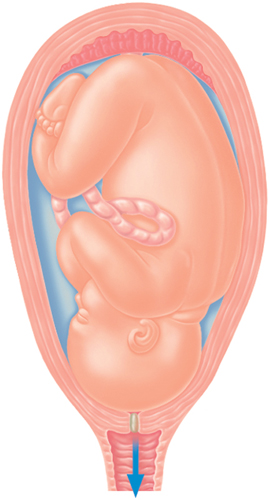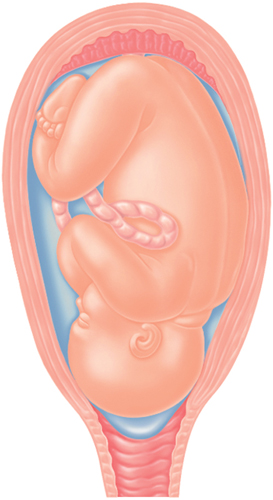You may be anxious to get your delivery over with, or
feel that you aren’t ready for labor. This can be an emotional time, so
try to stay calm. This section helps you identify the symptoms and
signs of labor and takes you through the changes that occur as your body
gets ready to give birth.
NOTE
Waiting for your labor to start can be both frustrating and terribly exciting.

Approaching Labor
As your pregnancy comes to an end, your cervix starts to soften as your body prepares for the forthcoming labor and birth.
As labor approaches, your
body starts to prepare itself for the task ahead and you may notice
various physical symptoms and signs that labor is about to start. Not
every woman experiences labor in the same way, and certain signs can
occur either before labor starts or during labor.
Common physical symptoms
Toward the end of
your pregnancy, you may experience a sensation of building pressure or
cramping in your pelvic or rectal area. This pelvic cramping can feel
very similar to monthly menstrual cramps. A dull pain in your lower back
that comes and goes is common too. You may also notice an increase in
heartburn (acid reflux) and gassiness. Unless you have a high-risk
pregnancy, there is no need to go to the hospital or call your doctor if
you experience any of these symptoms in the later stages of your
pregnancy.
Your emotional state
This is a time of
waiting and many women busy themselves with household tasks. These
bursts of activity are often thought to be instinctual, as the mother
prepares the home for the new arrival, referred to as “nesting.” The
anticipation of what will happen during labor can give rise to a mixture
of emotions, from fear and anxiety to excitement and impatience. Women
may feel fearful about how much pain they will feel or how uncomfortable
they will be with bodily functions. Nothing can prepare you fully for
how you will feel in labor, but the more you understand about pain
relief options
beforehand, the more confident you will feel about your ability to
manage. It’s also thought that by being informed and prepared, you are
likely to reduce your anxiety during labor, which in itself can enable
you cope better with the pain of contractions.
To prepare your body for the task ahead,
ensure that you get plenty of rest and relaxation. In addition to
getting a good night’s sleep, take a light nap during the day if you
feel fatigued.

Braxton Hicks’ contractions
One of the most
common symptoms of approaching labor is an increase in the strength and
frequency of Braxton Hicks’, or practice, contractions ,
which may be occurring up to four times an hour. The purpose of these
practice contractions is to prepare your uterus to deal with real labor
contractions so that labor progresses smoothly. Some women find Braxton
Hicks’ relatively painless, while others find these practice
contractions fairly uncomfortable, especially if the baby is quite low
and contractions cause increased pelvic pressure.
Apart from the level of
pain, one of the main ways to distinguish Braxton Hicks’ from real
contractions is that Bracton Hicks’ are irregular and they fade away,
whereas labor pains occur at regular intervals and gradually become
stronger, more intense, and closer together. The other main difference
between Braxton Hicks’ contractions and real ones is that, unlike
Braxton Hicks’, real contractions cause your cervix to dilate, which
indicates that labor is beginning.
Engagement of the head
With a first baby,
dropping down of the baby’s head into your pelvis, known as engagement,
usually means that labor is likely to start soon. In second and
subsequent pregnancies, engagement may not occur until the start of
labor.
You can usually tell
that your baby’s position has changed in two ways. First, you may notice
that you have less discomfort in your upper abdomen or around your ribs
because the downward movement releases some pressure. Second, you may
notice increased pressure or pain in your pelvic or vaginal area as the
baby’s head moves into position. Your walking may become more of a
waddle and you may have to use the bathroom more frequently than before.
In some cases, your baby’s head may pinch some of the nerves that run
through your pelvis and you may experience sciatica, a sharp electric
pain that runs down the outside of your leg to your outside toes .
The “bloody show”
In pregnancy, a plug
of mucus forms at the end of the cervix to prevent infection from
entering the uterus. At the end of pregnancy, as the cervix softens and
widens, this plug is dislodged and comes out through the vagina. When
this occurs, you may see a discharge known as the “bloody show”;
although some women don’t notice anything. The discharge may appear as a
thick, clear or yellow clump that looks like mucus from your nose. It’s
common for small amounts of blood to be present due to small tears in
the cervix as the plug comes away.
Losing the plug of
mucus usually means that labor will begin soon and you should make plans
to leave for the hospital in the near future (within 12 hours).
However, if loss of the plug is accompanied by other symptoms, such as
painful, frequent contractions, heavy bleeding or leaking fluid
(indicating your water has broken), you should call your doctor or
hospital immediately.
Water breaking
Rupture of the
amniotic membranes, called the water breaking, usually occurs once labor
has started, but it can happen earlier. If this happens, it often means
that labor is imminent. For some, a big gush of fluid is a clear sign
that their water has broken, while for others there may be a trickle and
it can be hard to determine if the amniotic fluid is leaking. Also,
since many women have trouble controlling their bladder in pregnancy,
telling the difference between urine and amniotic fluid can be hard. One
way to tell is to wear a sanitary pad. If the pad quickly becomes
soaked, your water has probably broken. Amniotic fluid also has an odor
that is different than urine, even to nonprofessional noses.
Monitoring after the water breaks
If you think your
water has broken but contractions haven’t started, contact your doctor
or the hospital for advice. If you’re due, there are no complications,
and your baby’s head is engaged, you may be advised either to stay at
home for a while to see if labor starts, or will be asked to be seen at
the hospital. This is because, once your water has broken, your baby has
lost the protective membrane surrounding him or her, which means there
is an increased risk of an infection reaching your baby. The doctor
should check your file to see if you’re Group B Strep (GBS)-positive,
and if you are, you’ll be admitted and started on IV antibiotics. She
may also monitor your baby’s heartbeat
to check that your baby isn’t distressed. If you’re GBS-negative and
all is well, you may be able to return home, or stay at home, for a set
amount of time and an appointment will be made to see how you’re
progressing. If labor doesn’t start within 24 hours (the timeframe may
be shorter in some hospitals), the hospital may suggest an induction .
As you approach labor, you will experience irregular contractions; these will increase in strength and regularity as labor progresses.

Early contractions
As your body prepares to
go into labor, you will start to experience mild and irregular
contractions. These differ from Braxton Hicks’ since they build
gradually and will soften and dilate the cervix.
Preparing for labor
The period before
labor starts can last for hours or even days, particularly with a first
labor. So that you can manage when you go into labor, you need to take
care of yourself during this pre-labor stage.
Stay well rested so that you aren’t completely exhausted when you go into labor.
If you’re having trouble resting,
possibly because of anxiety or discomfort, try practicing relaxation
techniques, such as breathing or visualization techniques, whereby you
focus on a tranquil setting to induce a state of calm.
Continue eating to keep your energy levels up
and provide fuel for the days ahead. You may not feel like eating a
large meal; instead eat little and often. Opt for wholesome snacks such
as dried fruit, nuts, or a whole-wheat sandwich, and drink lots of
fluids.
If you’re suffering with back pain, try showering in warm water or taking a warm bath.
However, be careful when showering, since pregnancy increases your
chances of feeling dizzy, and avoid a prolonged bath in very hot water
since this may not be good for your baby.
A lower back massage is comforting and a good way to relax and ease discomfort—ask your partner to give you a soothing massage.
No one is sure exactly what triggers labor, but it seems the process varies with each species.
In sheep, a drop
in progesterone signals the start of labor. In mice, babies release
proteins to signal their maturity, which in turn triggers labor. In
humans, little is known about the signals that start labor although
there are many theories. Studies suggest that the production of hormones
such as corticotrophin-releasing hormone (CRH) by the uterus and
placenta may play a role. It’s also thought that an increase in
pro-inflammatory substances known as cytokines may be involved. Whatever
the trigger, it’s likely that the onset of labor involves a biological
communication between your baby and your body to indicate that your baby
is ready to be born.
Signs of approaching labor
Although each woman’s experience of labor differs
and there are no hard and fast rules as to what will happen when, there
are signs that indicate that labor is likely to start either imminently
or within a matter of days. One of the classic signs that labor isn’t
far away is a “bloody show” (see The “bloody show”),
when you lose the plug of mucus that has protected your baby during
pregnancy. The other indisputable sign that labor will be shortly
underway is that your cervix begins to dilate, although of course this
will only be visible during an internal examination.
One other sign that labor may be about to start is if your water breaks. However, for the majority of women this happens later on during established labor.
As the cervix starts to soften and shorten,
the thick plug of mucus that protected your baby from infection during
pregnancy comes away and falls out of the vagina, an event referred to
as a “bloody show.” When this happens, you may notice a yellowish
discharge.

The amniotic membrane bulges through the cervix
as the baby’s head presses down. When the membranes break (water
breaking), labor is imminent, or may have already started. The amniotic
fluid may pass out as a gush of fluid or a trickle.

When to seek help
Make your way to the hospital or seek advice if any of the following occur:
You have vaginal bleeding that is like a period or heavier.
You’re leaking amniotic fluid or leaking greenish fluid that could indicate the baby is distressed.
The baby isn’t moving as expected (ask your doctor for advice).
When am I in labor?
A common concern of many
women is how they will know when they are in labor. The following are
indications that labor is truly underway.
You are having contractions that are becoming stronger and more intense, lasting longer, and the interval between the contractions is getting shorter.
Changing your position or walking around doesn’t ease the intensity of the contraction.
The contractions start high in your abdomen and move down through the uterus and lower back, rather than occurring only in the lower abdomen.
Your water breaks (see Monitoring after the water breaks) while you’re having contractions.